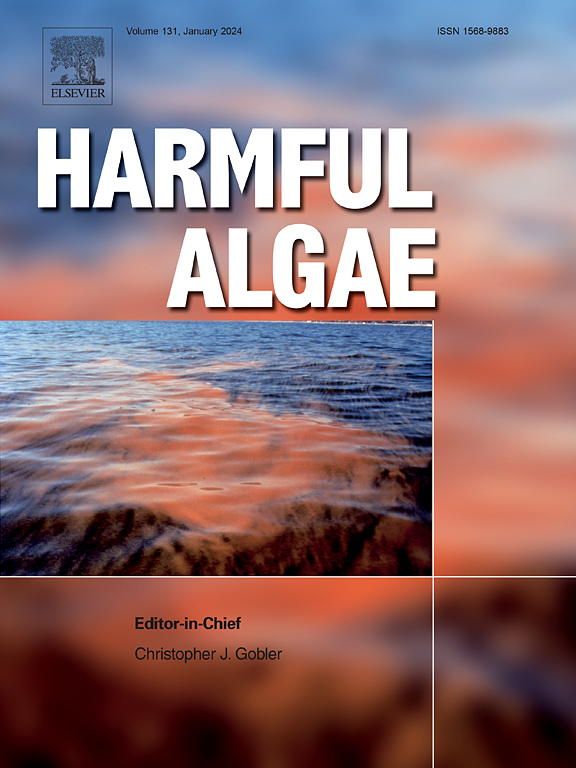Spatiotemporal distribution, composition, and influencing factors of lipophilic marine algal toxins in the Beibu Gulf, China: Implications for necessity of offshore seawater monitoring
IF 4.5
1区 生物学
Q1 MARINE & FRESHWATER BIOLOGY
引用次数: 0
Abstract
Lipophilic marine algal toxins (LMATs) are persistent, bioaccumulative metabolites that pose significant threats to marine biodiversity and seafood safety. To comprehensively understand LMATs pollution in offshore natural fishing grounds, we investigated the spatiotemporal distribution and composition of 13 LMATs in surface seawater in Beibu Gulf's offshore area, along with their key influencing factors and latitudinal variations across coastal regions in China. We detected 20-methyl spirolide G (SPX20G) for the first time in coastal waters in China, alongside other frequently detected LMATs, including okadaic acid (OA), dinophysistoxin-1 (DTX1), pectenotoxin-2 (PTX2), azaspiracid-1 (AZA1), azaspiracid-2 (AZA2), gymnodimine (GYM), and 13-desmethyl spirolide C (SPX1). Significant seasonal variations were observed, with summer exhibiting eight LMAT types and higher total LMAT concentrations (ΣLMATs) (16.92 ± 20.45 ng/L) compared to winter's five LMAT types and ΣLMATs concentrations at 5.63 ± 3.30 ng/L. Predominant PTX2 and OA concentrations showed a decreasing trend from northern to southern Beibu Gulf, while other LMATs were distributed in patches, particularly in summer. Notably, cyclic imines (GYM and SPX1) were detected with high frequencies and concentrations, underscoring the need for their monitoring. Spearman correlation and redundancy analyses identified water depth, chlorophyll a (Chla), temperature, salinity, nutrients (DIN:DIP and SiO₃²⁻), and dissolved oxygen (DO) as key factors influencing LMATs distribution in the Beibu Gulf. Latitudinal analysis of LMAT contents across Chinese waters revealed DTX1 as more prevalent at higher latitudes, and GYM, SPX1, and AZA1 more common at lower latitudes, while ΣLMATs concentrations from this study ranked at moderate to high levels compared to other regions. Therefore, special attention is required for LMATs pollution in offshore fishing areas.

中国北部湾亲脂藻毒素时空分布、组成及影响因素:近海海水监测的必要性
亲脂性海洋藻类毒素(LMATs)是一种持久性、生物蓄积性代谢物,对海洋生物多样性和海产品安全构成重大威胁。为全面了解近海天然渔场LMATs污染情况,研究了北部湾近海表层海水中13种LMATs的时空分布、组成、主要影响因素及其在中国沿海地区的纬度变化。本研究首次在中国沿海水域检测到20-甲基螺内酯G (SPX20G),同时还检测到其他常见的LMATs,包括冈田酸(OA)、甲藻毒素-1 (DTX1)、果皮毒素-2 (PTX2)、氮唑匹斯酸-1 (AZA1)、氮唑匹斯酸-2 (AZA2)、裸子二胺(GYM)和13-二甲基螺内酯C (SPX1)。夏季有8种LMAT类型,LMAT总浓度(ΣLMATs)(16.92±20.45 ng/L)高于冬季的5种LMAT类型,ΣLMATs浓度为5.63±3.30 ng/L。从北部湾北部到南部,主要的PTX2和OA浓度呈下降趋势,而其他LMATs呈斑块状分布,特别是在夏季。值得注意的是,环亚胺(GYM和SPX1)的检测频率和浓度都很高,强调了对其进行监测的必要性。Spearman相关和冗余分析发现,水深、叶绿素a (Chla)、温度、盐度、营养物质(DIN:DIP和SiO₃²⁻)和溶解氧(DO)是影响北部湾LMATs分布的关键因素。对中国海域LMAT含量的纬度分析显示,DTX1在高纬度地区更为普遍,GYM、SPX1和AZA1在低纬度地区更为常见,而ΣLMATs浓度与其他地区相比处于中高水平。因此,需要特别注意近海渔区的LMATs污染。
本文章由计算机程序翻译,如有差异,请以英文原文为准。
求助全文
约1分钟内获得全文
求助全文
来源期刊

Harmful Algae
生物-海洋与淡水生物学
CiteScore
12.50
自引率
15.20%
发文量
122
审稿时长
7.5 months
期刊介绍:
This journal provides a forum to promote knowledge of harmful microalgae and macroalgae, including cyanobacteria, as well as monitoring, management and control of these organisms.
 求助内容:
求助内容: 应助结果提醒方式:
应助结果提醒方式:


